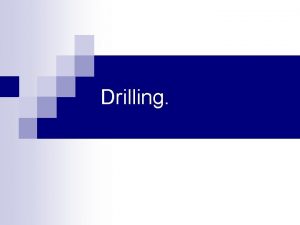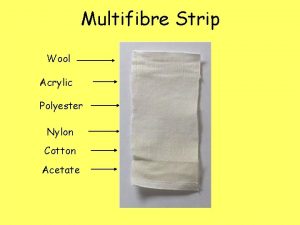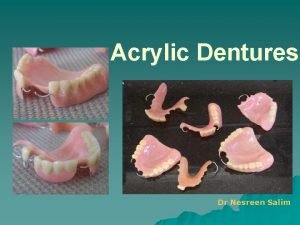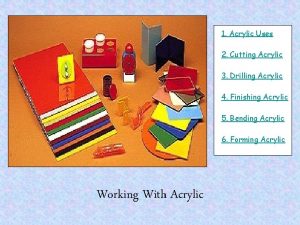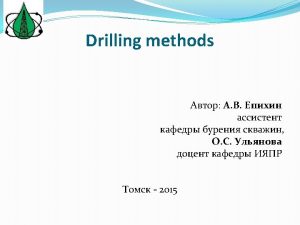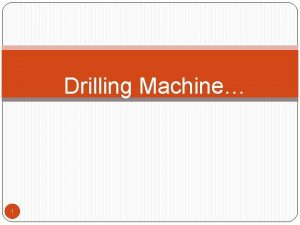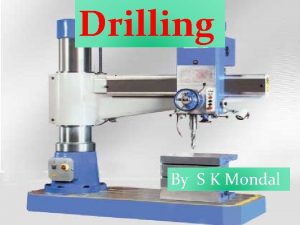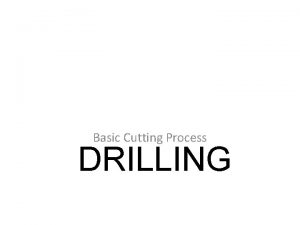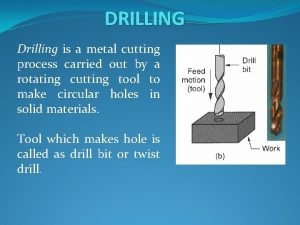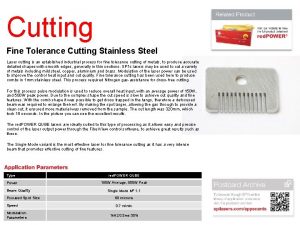1 Acrylic Uses 2 Cutting Acrylic 3 Drilling



















- Slides: 19

1. Acrylic Uses 2. Cutting Acrylic 3. Drilling Acrylic 4. Finishing Acrylic 5. Bending Acrylic 6. Forming Acrylic Working With Acrylic

Acrylic Uses Opaque Acrylic Dial Transparent Acrylic Salad Servers Acrylic is available in both transparent and opaque forms. It is used for Baths, sinks and fish tanks. . . from colourful clocks to replacement skylights. . . Clear Boxes Menu Stands

Acrylic Properties Acrylic is classed as a Thermoplastic. This means that it becomes soft and mouldable on heating without undergoing any significant chemical change. This process can be repeated many times. Acrylic is available in a wide range of colours. Acrylic sheet is supplied with a protective film covering attached to each side. This is to prevent the acrylic being scratched and should be left in place as long as possible. Protective covering Bending Acrylic on a strip heater Letter Rack model

Cutting Acrylic Coping Saw Cut close to the vice to reduce the risk of the acrylic cracking While the Coping Saw can be used to cut simple curves in acrylic sheet it tends to leave a coarser finish.

Cutting Acrylic Hacksaw The Hacksaw can be used to cut straight lines in metal and plastic.

Cutting Acrylic Junior Hacksaw The Jnr Hacksaw can be used to cut straight lines in small pieces of metal and plastic.

Cutting Acrylic Scroll Saw When replacing the blade, make sure the teeth point downward. This helps hold the work on the table as you cut. The quickest method of cutting intricate shapes in acrylic is the Scroll Saw. This machine is capable of producing an excellent finish.

Drilling Acrylic To obtain the best results when drilling Acrylic it is better to use a special drill bit. Conventional high speed drill bits do not work well with hard plastics. They will "ride up" a conventional drill bit and crack. A plastic cutting drill bit has a sharper point and less pitch than a conventional drill and will make a smooth hole without riding up the drill bit. Slow to medium speeds work best when working with acrylics. If customised plastics drill bits are unavailable then conventional twist drill bits can be used however great care must be taken to hold the Acrylic securely and you must lower the drill at a slow even rate.

Filing Acrylic Chipped Edge When cutting Acrylic it is easy to chip the edges. To remove these chips and give the edge a good finish follow these steps.

Stage 1 : Use a course file to remove the worst of the chips.

Stage 2 : Hold the file at right angles to the work piece and Draw File the edge

Wet & Dry Silicon carbide paper Stage 3: Finish the edge with silicon carbide paper (Make sure you remove all file marks)

Acrylic Polish Stage 4: Finally apply a little acrylic polish to a soft cloth and polish the edge.

The 4 Stages of Finishing the Edges of Acrylic • • Cross file Draw file Wet & Dry Paper Polish

Bending Acrylic Strip Heater The Strip Heater is used to bend sheet acrylic. The acrylic is held above the heating element and turned over every 30 seconds. After 2 to 3 min the plastic will bend easily. Remember the Strip Heater can get very hot

Bending Acrylic Wooden Former To obtain more accurate results it is often better making a wooden former to bend the acrylic round. Hot Wire Strip Heater

Forming Acrylic The oven can be used to heat a whole sheet of acrylic to make it soft and flexible. This soft acrylic can then be pressed into shape in a mould. A typical example is this acrylic windscreen shown on the right Oven

Vacuum Forming Acrylic Bath Moulds Acrylic Sink Vacuum Forming Machine Acrylic can also be Vacuum Formed to produce larger items like baths and sinks. (See Focus on Plastics for further details)

The End
 Drilling diagram
Drilling diagram Modified palm and thumb grasp in dentistry
Modified palm and thumb grasp in dentistry What is the musical classification of shank
What is the musical classification of shank Marking tools in sewing
Marking tools in sewing Orthogonal cutting is dimensional metal cutting
Orthogonal cutting is dimensional metal cutting Bin angled chisel
Bin angled chisel Retracting dilating probing instruments
Retracting dilating probing instruments Acrylic wool
Acrylic wool Posh
Posh Emulsion acrylic adhesive
Emulsion acrylic adhesive Matrix acrylic aurium
Matrix acrylic aurium Internal porosity of denture base
Internal porosity of denture base Spoon denture design
Spoon denture design Kckcc
Kckcc Acrylic rpd
Acrylic rpd Parts of rpd
Parts of rpd Acrylic fabric advantages and disadvantages
Acrylic fabric advantages and disadvantages Trepanning operation in drilling machine
Trepanning operation in drilling machine Anwr drilling pros and cons
Anwr drilling pros and cons Offshore drilling
Offshore drilling
